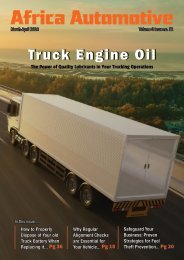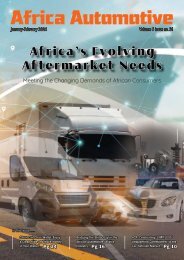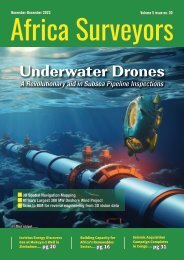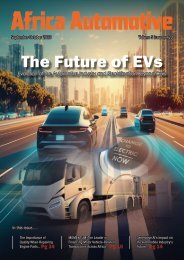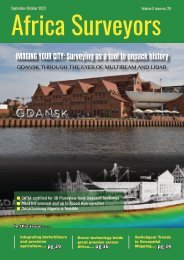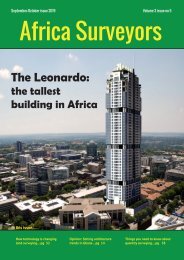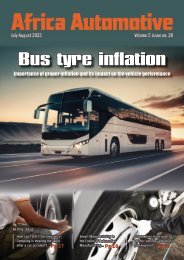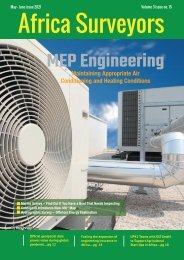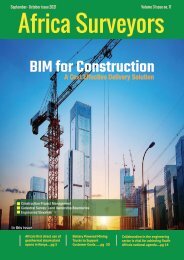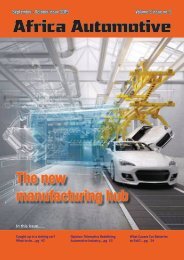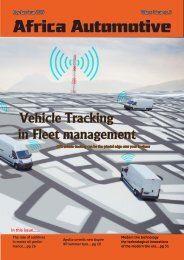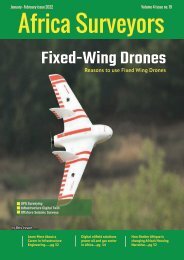Africa Automotive March-April digital issue 2023
Africa Automotive prides itself to be the ONLY Africa’s leading and MOST authoritative magazine for the automotive industry in Africa with printed copies for the automotive industry decision makers in both government, NGO’s and private sector. The Bi-monthly magazine offers cost effective advertising services that get results and improves growth in the auto B2C and B2B sector, keeping an eye on latest technologies in Africa and across the world, the magazine predominately covers the developments in the Africa auto industry.
Africa Automotive prides itself to be the ONLY Africa’s leading and MOST authoritative magazine for the automotive industry in Africa with printed copies for the automotive industry decision makers in both government, NGO’s and private sector. The Bi-monthly magazine offers cost effective advertising services that get results and improves growth in the auto B2C and B2B sector, keeping an eye on latest technologies in Africa and across the world, the magazine predominately covers the developments in the Africa auto industry.
- TAGS
- automotivetyres
- engineoiladditives
- automotiverustremover
- cardealers
- electriccars
- hydrogenpoweredvehicles
- africabusinesssummit
- trucks
- vehiclefinancing
- automotivebatteries
- carmaintenance
- africaautomotivenews
- automotivesuspension
- automotivemanufacturing
- nexusautomotive
- automotiveindustry
- automotiveaftermarket
- automotivemarketing
- africaautomotive
- africa
Create successful ePaper yourself
Turn your PDF publications into a flip-book with our unique Google optimized e-Paper software.
March-April issue l 2023
low cost, compact size, advanced designs, better ride
comfort, and better maneuverability. This has increased
the adoption of multilink suspensions in these vehicles.
The decreasing cost of multilink suspension and ease
of adjustment has increased the adoption of multilink
suspension in the rear axle in mid to high-segment
cars, as these segment customers demand higher ride
comfort. Mahindra Scorpio, Volkswagen Tiguan, and Kia
Sportage are some of the common SUVs equipped with
multilink suspensions. Globally, the multilink suspension
volume market is expected to grow at 2.7% over the
forecast period.
Increased adoption of air suspension systems in
buses and trucks
Air suspension replaces a conventional steel spring
suspension in heavier vehicle applications, like trucks,
tractor-trailers, and passenger buses, thus reducing
overall vehicle weight and subsequent CO2 emission.
Earlier, the leaf spring suspension was used in heavy
commercial vehicles. The low manufacturing cost and
the ability to distribute the load over a wider area made
leaf springs a preferred choice for heavy trucks and
buses. However, semi-active and active suspensions have
been developed due to technological advancements
allowing the air suspension system to enter the market.
Adopting the air suspension system is higher in buses
as comfort and ride control are primary requirements in
buses. Hence, the demand for air suspension in luxury
buses has risen significantly.
Currently, air suspension is no longer a premium feature.
Still, it has become a standard feature, especially in
developed regions such as Europe and North America,
as customers prefer comfort and can pay higher prices
for the products. Companies that provide air suspension
systems in their truck and bus models include Volvo
(9400 B8R, FM series), Daimler AG (Actros L, Tourismo,
and Citaro series), Scania (City Bus 4×2, S-series), and
ISUZU (LT 134PR BUS series). This feature is still in its
introductory phase in Asia Pacific due to the region’s cost
sensitivity toward products.
Bus air suspension systems have evolved in terms
of technology, components, and other parameters.
In the case of heavy-duty trucks, the demand for
air suspension is growing, owing to the demand for
efficient transportation of goods, increasing special
applications of trucks, such as refrigerated trucks and
containers carrying fragile and expensive goods. The
increasing demand for HCVs also aids this growth due
to the globally booming e-commerce sector. The global
HCV production is expected to grow from ~0.8 million
units in 2022 to 8.6 million units by 2027, according to
MarketsandMarkets analysis.
As the air suspension system increases its penetration
in HCVs, it will likely follow the growth of global HCV
Automotive Suspension
vehicle production, as evidenced by the projections
below.
Automotive Suspension – Supply Chain and
Ecosystem:
The automotive suspension market supply chain
includes suspension component manufacturers, system
manufacturers, and OEMs. Component suppliers provide
suspension components such as shock absorbers,
springs, links, and control arms to tier-1 system
manufacturers. The system integrator integrates a
complete suspension system and offers it to various
OEMs per specifications.
Automotive Suspension – Future Revenue Shift
and Recommendations:
The growth of the automotive suspension market is
directly proportional to the production of passenger
vehicles. In line with growing luxury vehicles, the market
for premium SUVs has risen significantly. According
to MarketsandMarkets Analysis, of total premium cars
produced globally, the share of premium SUVs stood at
~53% in 2016, which grew to ~68% in 2022. US, Canada,
China, Japan, and South Korea lead the premium SUVs
market, constituting more than 90% of total production
globally. The factors attributing to the growth of
premium SUVs over premium sedans are better and
more powerful engine performance, and hence the
demand for safety and comfort ha increased which
has led to the installation of independent suspension
systems in SUVs and luxury passenger cars.
On the other hand, the rising concerns about global
warming and the federal and state governments’
support to reduce air pollution are driving the EV
market. Electric vehicles will witness high penetration
of MacPherson strut, double wishbone, and multilink
suspension systems. High-end EV models such as
Porsche Taycan and BMW i4 use air suspension in both
front and rear axles. Mid-segment vehicles such as the
Kia EV6 and Tata Nexon use MacPherson strut in front
and torsion beam or multilink suspension in the rear.
Thus, the semi-active and active systems are expected
to register high growth rates of 2.9% and 5.4% during
the forecast period. With the increased demand of semiactive
and active systems, the adjacent markets such
as sensors, ECUs and other electronic devices market
are also growing. Hence, suspension manufacturers
& Tier II suppliers have adopted various growth such
as new product launches, mergers & acquisitions,
supply contracts, partnerships, and others to diversify
their global presence and increase their market share.
The automotive suspension market is consolidated.
ZF Friedrichshafen AG, Tenneco Inc., Continental AG,
ThyssenKrupp AG, and KYB Corporation are the top
players in the market, with a 60-70% share. These
players are based in North America, Europe, and Asia
Pacific.
Africa Automotive News l 2023 27





